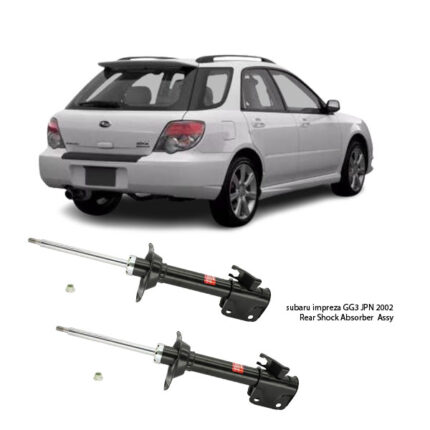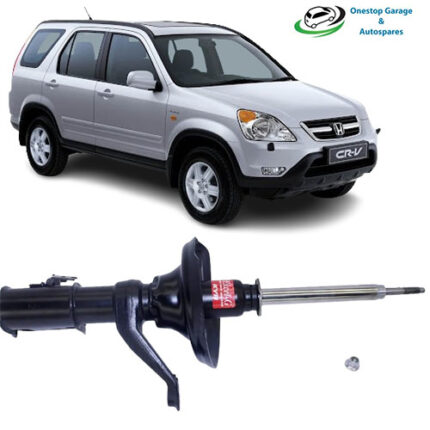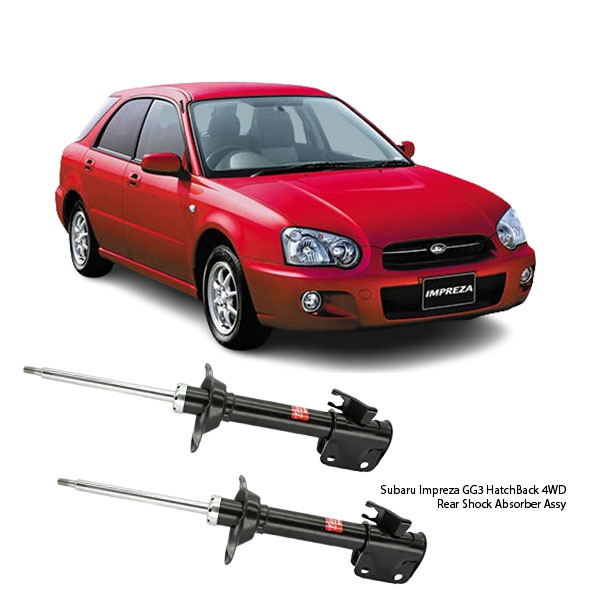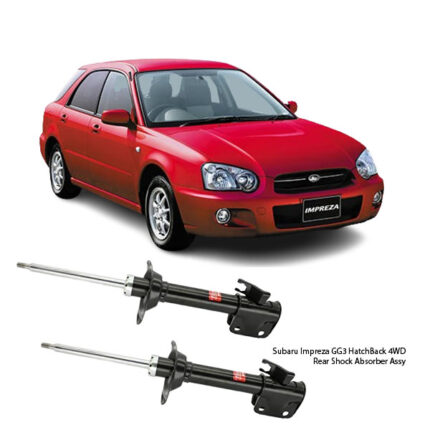Get Subaru Impreza GG3 HatchBack 4WD Rear Shock Absorber Assy 334303 in Kenya
The rear shock absorber assembly is a crucial component in a vehicle’s suspension system, playing a significant role in maintaining comfort, stability, and control. Though it operates mostly out of sight, its function is critical to both everyday driving and long-term vehicle performance. This system is engineered to absorb and dampen the impact of road irregularities, ensuring a smooth ride and better handling.
Purpose and Function
At its core, the primary job of a rear shock absorber is to control the movement of the suspension and minimize oscillation. As a vehicle drives over bumps, potholes, or uneven terrain, the suspension compresses and rebounds. Without a shock absorber, this motion would continue, making the ride extremely uncomfortable and unsafe. The shock absorber manages this motion by converting kinetic energy into heat energy, which it then dissipates through hydraulic fluid or gas.
Components of a Rear Shock Absorber Assembly
A typical rear shock absorber assembly consists of several interconnected components that work together to ensure its performance. These include:
-
Shock Absorber (Damper)
The central piece of the assembly. It usually contains a piston that moves within a cylinder filled with hydraulic fluid or pressurized gas. The piston’s movement is resisted by valves that slow down the fluid flow, thus damping the motion of the suspension. -
Coil Spring (in some types)
In certain rear assemblies, especially in strut-based or coil-over designs, the shock absorber is integrated with a spring. The spring supports the vehicle’s weight and absorbs large impacts, while the damper controls the motion. -
Mounting Bushings and Bolts
These rubber or polyurethane bushings are located at the ends of the shock absorber and act as cushions between the metal parts of the vehicle and the shock absorber. They also reduce vibration and noise transmission. -
Dust Cover/Boot
A protective sleeve that guards the shock shaft against dirt, moisture, and debris, extending the life of the component. -
Bump Stop
Also known as a jounce bumper, it prevents the suspension from bottoming out during extreme compression.
Types of Rear Shock Absorbers
Depending on the design of the vehicle’s suspension, rear shock absorbers come in different forms:
-
Twin-Tube Shock Absorbers
The most common type, consisting of an inner and outer tube. The inner tube contains the piston and hydraulic fluid, while the outer tube stores excess fluid. Twin-tube designs offer a good balance of comfort and performance. -
Mono-Tube Shock Absorbers
These use a single tube and a floating piston to separate the hydraulic fluid from the gas. They generally provide better performance and cooling, especially under heavy use. -
Coilover Shock Absorbers
These integrate a coil spring and shock absorber into a single assembly. They are often used in performance-oriented or aftermarket suspension systems. -
Air Shocks
These use pressurized air to assist or replace the traditional coil spring. They are adjustable and can offer a variable ride height or stiffness depending on load and driving conditions.
Working Mechanism
When the rear wheels hit a bump, the vertical motion pushes the suspension upward. The coil spring (if present) compresses to absorb the energy. Simultaneously, the shock absorber’s piston moves inside its cylinder. The internal valves regulate the flow of hydraulic fluid, creating resistance and damping the movement. When the spring rebounds, the shock absorber again controls the return movement, ensuring the vehicle doesn’t bounce uncontrollably.
The entire cycle happens in fractions of a second, and this continuous action keeps the tires in contact with the road, improves braking, and ensures steering stability.
Importance in Vehicle Dynamics
Without a properly functioning rear shock absorber, a vehicle becomes difficult to control. Some of the key roles it plays in vehicle dynamics include:
-
Ride Comfort
By dampening the vibrations and jolts from the road, the shock absorber prevents discomfort to passengers and cargo. -
Handling and Control
It keeps the rear tires firmly planted on the ground, especially during cornering, acceleration, or braking. -
Load Management
In vehicles carrying heavy or uneven loads, the rear shock absorber ensures stability by distributing weight and managing suspension compression. -
Safety
A worn or damaged shock absorber increases braking distances and causes poor traction, especially on slippery or uneven roads.
Signs of a Failing Rear Shock Absorber
Over time, shock absorbers wear out due to continuous use and exposure to elements. Some common signs of wear or failure include:
-
Unusual Noise
Clunking or banging sounds when driving over bumps could indicate worn bushings or internal damage. -
Excessive Bouncing
If the vehicle bounces several times after hitting a bump, the shock absorber may not be damping correctly. -
Uneven Tire Wear
Poor damping can cause tires to bounce and wear unevenly or prematurely. -
Leaking Fluid
Visible oil on the outside of the shock absorber is a sign that the internal seals may have failed. -
Swerving or Nose-Diving
Instability during braking or turns often points to weak rear or front shock absorbers.
Maintenance and Replacement
While rear shock absorbers are designed to last for tens of thousands of kilometers, they are not immune to aging. Routine inspections during service intervals can help detect issues early. Technicians will usually look for leaks, corrosion, physical damage, and test the ride quality.
Replacement should always be done in pairs (both rear units at once) to maintain balance and consistent performance. Using high-quality replacement parts ensures durability and optimal performance.
The Impact on Other Systems
Neglecting rear shock absorbers can have a ripple effect on other systems in the vehicle:
-
Suspension Wear
Overworked springs, bushings, and joints may wear out faster. -
Tire Damage
Improper damping can cause cupping and irregular tread wear. -
Brake System
Rear-end instability can affect braking efficiency and increase stopping distances. -
Body and Frame Stress
Vibrations from poor shock absorption can lead to body rattles, cracked welds, and interior component wear.
Conclusion
The rear shock absorber assembly is more than just a comfort feature — it’s a vital safety and performance component. From maintaining tire contact with the road to ensuring stability under all driving conditions, its role cannot be overstated. Regular maintenance and timely replacement are key to keeping the vehicle performing smoothly and safely. Though often overlooked, this behind-the-scenes workhorse deserves attention and care from any vehicle owner or technician.
Follow us on Facebook for more parts.




